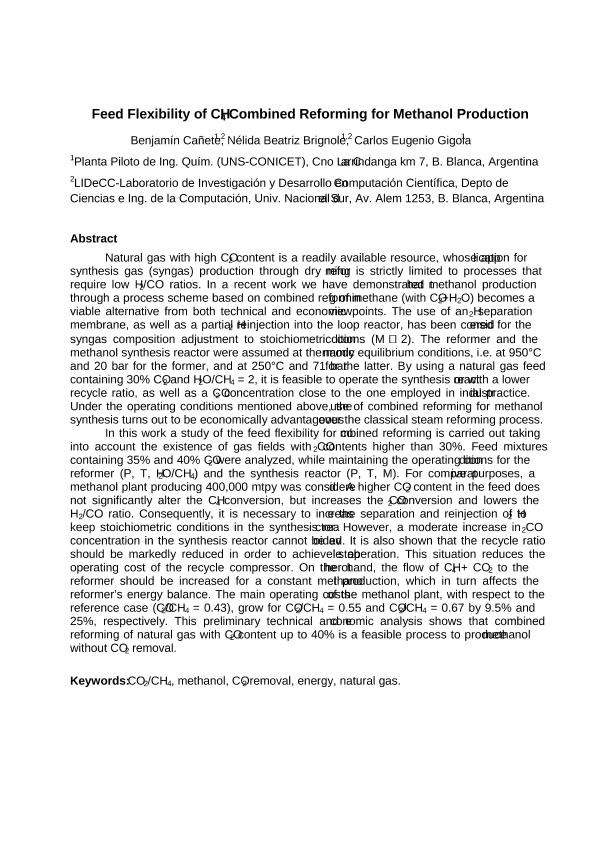Mostrar el registro sencillo del ítem
dc.contributor.author
Cañete, Benjamin

dc.contributor.author
Brignole, Nélida Beatriz

dc.contributor.author
Gigola, Carlos Eugenio

dc.date.available
2017-09-29T19:25:58Z
dc.date.issued
2015-06-10
dc.identifier.citation
Cañete, Benjamin; Brignole, Nélida Beatriz; Gigola, Carlos Eugenio; Feed Flexibility of CH4 Combined Reforming for Methanol Production; Elsevier; Computer-Aided Chemical Engineering; 37; 10-6-2015; 1343-1348
dc.identifier.issn
1570-7946
dc.identifier.uri
http://hdl.handle.net/11336/25458
dc.description.abstract
Natural gas with high CO2 content is a readily available resource, whose application for synthesis gas (syngas) production through dry reforming is strictly limited to processes that require low H2/CO ratios. In a recent work we have demonstrated that methanol production through a process scheme based on combined reforming of methane (with CO2+H2O) becomes a viable alternative from both technical and economic viewpoints. The use of an H2 separation membrane, as well as a partial H2 reinjection into the loop reactor, has been considered for the syngas composition adjustment to stoichiometric conditions (M ≅ 2). The reformer and the methanol synthesis reactor were assumed at thermodynamic equilibrium conditions, i.e. at 950°C and 20 bar for the former, and at 250°C and 71 bar for the latter. By using a natural gas feed containing 30% CO2 and H2O/CH4 = 2, it is feasible to operate the synthesis reactor with a lower recycle ratio, as well as a CO2 concentration close to the one employed in industrial practice. Under the operating conditions mentioned above, the use of combined reforming for methanol synthesis turns out to be economically advantageous over the classical steam reforming process. In this work a study of the feed flexibility for combined reforming is carried out taking into account the existence of gas fields with CO2 contents higher than 30%. Feed mixtures containing 35% and 40% CO2 were analyzed, while maintaining the operating conditions for the reformer (P, T, H2O/CH4) and the synthesis reactor (P, T, M). For comparative purposes, a methanol plant producing 400,000 mtpy was considered. A higher CO2 content in the feed does not significantly alter the CH4 conversion, but increases the CO2 conversion and lowers the H2/CO ratio. Consequently, it is necessary to increase the separation and reinjection of H2 to keep stoichiometric conditions in the synthesis reactor. However, a moderate increase in CO2 concentration in the synthesis reactor cannot be avoided. It is also shown that the recycle ratio should be markedly reduced in order to achieve stable operation. This situation reduces the operating cost of the recycle compressor. On the other hand, the flow of CH4 + CO2 to the reformer should be increased for a constant methanol production, which in turn affects the reformer’s energy balance. The main operating costs of the methanol plant, with respect to the reference case (CO2/CH4 = 0.43), grow for CO2/CH4 = 0.55 and CO2/CH4 = 0.67 by 9.5% and 25%, respectively. This preliminary technical and economic analysis shows that combined reforming of natural gas with CO2 content up to 40% is a feasible process to produce methanol without CO2 removal.
dc.format
application/pdf
dc.language.iso
eng
dc.publisher
Elsevier

dc.rights
info:eu-repo/semantics/openAccess
dc.rights.uri
https://creativecommons.org/licenses/by-nc-sa/2.5/ar/
dc.subject
Combined Reforming
dc.subject
Methanol Production
dc.subject
Carbon Dioxide
dc.subject.classification
Otras Ingeniería Química

dc.subject.classification
Ingeniería Química

dc.subject.classification
INGENIERÍAS Y TECNOLOGÍAS

dc.title
Feed Flexibility of CH4 Combined Reforming for Methanol Production
dc.type
info:eu-repo/semantics/article
dc.type
info:ar-repo/semantics/artículo
dc.type
info:eu-repo/semantics/publishedVersion
dc.date.updated
2017-09-25T18:12:07Z
dc.journal.volume
37
dc.journal.pagination
1343-1348
dc.journal.pais
Países Bajos

dc.journal.ciudad
Amsterdam
dc.description.fil
Fil: Cañete, Benjamin. Consejo Nacional de Investigaciones Científicas y Técnicas. Centro Científico Tecnológico Conicet - Bahía Blanca. Planta Piloto de Ingeniería Química. Universidad Nacional del Sur. Planta Piloto de Ingeniería Química; Argentina
dc.description.fil
Fil: Brignole, Nélida Beatriz. Consejo Nacional de Investigaciones Científicas y Técnicas. Centro Científico Tecnológico Conicet - Bahía Blanca. Planta Piloto de Ingeniería Química. Universidad Nacional del Sur. Planta Piloto de Ingeniería Química; Argentina
dc.description.fil
Fil: Gigola, Carlos Eugenio. Consejo Nacional de Investigaciones Científicas y Técnicas. Centro Científico Tecnológico Conicet - Bahía Blanca. Planta Piloto de Ingeniería Química. Universidad Nacional del Sur. Planta Piloto de Ingeniería Química; Argentina
dc.journal.title
Computer-Aided Chemical Engineering
dc.relation.alternativeid
info:eu-repo/semantics/altIdentifier/doi/http://dx.doi.org/10.1016/B978-0-444-63577-8.50069-3
dc.relation.alternativeid
info:eu-repo/semantics/altIdentifier/url/http://www.sciencedirect.com/science/article/pii/B9780444635778500693
Archivos asociados
